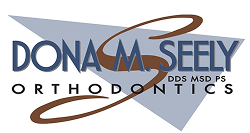Brushing and Flossing with Braces Near You
Keeping your teeth clean with braces requires the right technique and tools. A soft-bristled or bi-level manual toothbrush is highly effective for reaching around brackets and wires. Electric toothbrushes can also be a great option—as long as they’re set to a moderate power level.
However, Dr. Seely advises against using electric toothbrushes for patients with gum recession, as the vibration may cause further irritation or damage to sensitive areas. In these cases, a gentle manual toothbrush is the safer, healthier choice.
Brush with fluoride toothpaste at least twice daily for two minutes, ideally after meals. Clean all surfaces—front, back, and chewing areas—paying special attention to spots between wires, brackets, and gums where food particles can get trapped.
Start by brushing front surfaces with small circular motions. Tilt the brush toward the gum line to clean between braces and gums. Use a firm back-and-forth motion on chewing surfaces, and finish by brushing the back of the teeth like the front.
A water flosser (like a Waterpik) is a helpful tool for cleaning around braces, wires, and hard-to-reach areas. It uses a gentle, pressurized stream of water to remove food particles and plaque from between the teeth and along the gumline.
While it doesn’t replace regular flossing completely, using a water flosser daily can improve gum health, reduce inflammation, and make oral hygiene easier during orthodontic treatment. It’s especially useful for patients who struggle with traditional flossing.
.jpeg)
.png)
Special Brushing Tools
If you're having trouble cleaning the areas near brackets and wires, some special tools may help. One is the interdental toothbrush. It has a small tuft of bristles that stick up all around, like a pipe cleaner. Use it gently and carefully to clean the tiny spaces under wires and around bands and brackets.
Another special cleaning tool is the oral irrigator or "water pick." This device shoots a small stream of pressurized water at your teeth, which can help dislodge bits of food that become trapped in nooks and crannies. While it's easy to use, an oral irrigator isn't a substitute for a toothbrush or dental floss — but when used along with proper brushing and flossing techniques, it can be very effective.
Floss Fundamentals
To keep your teeth and gums clean and healthy, you need to floss at least once per day. But how do you floss under the archwire of your braces? It's not so hard with the help of a floss threader. Using this device is somewhat like threading a needle: You pull one end of floss through the threader, and then push the threader — carrying with it the free end of the floss — under the archwire. Now grasp the floss on each end and slide it up and down the sides of both teeth, and all the way under the gums until you hear a squeaky sound. Finally, pull it out and use a new section of floss for the next area.
%20(1).png)

Full Disclosure
Ever wonder how effective your tooth-cleaning techniques really are? There's an accurate way to tell, using special vegetable dyes called "disclosing solutions" or "disclosing tablets." As they dissolve in the mouth, these dyes highlight plaque and food debris that brushing has missed. You can then easily remove the dyed spots — and you'll know for sure if your oral hygiene methods need a little "brushing up."Keeping your teeth and gums healthy now is an investment in your future. It enables you to get the best results from your orthodontic treatment and starts you toward a brighter smile that can last for a lifetime.



.svg)
.svg)
